


© Mauro Baudino Collection - All rights reserved.




Historical Gallery
Historical Information.
This page summarizes some topics discussed in great details in the Paul Mauser book.The Experimental Paul Mauser C78 revolver.
Mauro Baudino, Co-Author - www.paul-mauser-archive.com Acknowledgement: Marc Erickson for the help in producing this study. The Paul Mauser experimental C78 (Zig-Zag) Revolver in 10.6mm black powder caliber is described here together with associated historical documents from the Paul Mauser Archive and with it's unique experimental ammunition and dismounting tool. This revolver is Paul Mauser's own experimental patent model developed to test and patent the C78 Hinged Frame variation, and documented in German patent 3903 - Innovations in Revolvers on the 9th of April 1878. It is a unique specimen, chambered for an experimental 10.6mm ammunition that is still associated with this revolver; in fact, the drawings in German patent 2564 dated 2nd of March 1878 and German patent 3903 on date 9th April 1878 referred to a specific necked bullet that was not retained in production versions of this handgun (see Figure 4 for the patent). Mauser's patent model can be considered as a laboratory of technical experiments and solutions, some of them retained and others discarded form the final Zig-Zag design. In the Paul Mauser Archive, several letters written from Wilhelm to Paul exchanged in 1878 are available. These letters tell us that Paul personally produced all the early prototypes and patent models of this handgun, and of course the one here presented, while Wilhelm was busy marketing the revolver to the German Army. Wilhelm wrote an average of two letters a day to Paul, one in the morning and one in the afternoon, reporting to him his progress, feedback on the revolver design and the improvements to be implemented. Paul changed these things in the patent model and shipped prototypes to Wilhelm to show not only to the German committee but also to Russian representatives that were very interested). In this short presentation, with the help of some photos, we will discuss the most evident features of the experimental revolver, leaving to a more detailed article the complete analysis of this historic revolver and relevant documentation. A very detailed article with all the historical details from the letters exchanged between Paul and Wilhelm is ready and will be published on the magazine Man at Arms for the Gun and Sword Collector . Figure number 1: The Paul Mauser Experimental Revolver is displayed with the unique necked 10.6mm ammunition that is still associated with the patent revolver; his dismounting tool and two rare documents from the Paul Mauser Archive. The document named Protokoll is the most important management document for both C78 and Reichrevolver made by Mauser and signed by Paul, Wilhelm and the Baron Heh von Luck. The other is one of the letters exchanged with Russian importer C. Wachter & Co. in St. Petersburg. In fact, Russia (Caucasian Army) was particularly interested in the revolver and Wilhelm travel to St. Petersburg to demonstrate it. The Paul Mauser experimental revolver is marked PATENT. on the hinge in order to highlight the primary reason this specific firearm was produced and GEBr MAUSER & Cie OBERNDORF a/N on the left side of the frame similar to the mark found on the solid frame C78 revolver . Figures number 2 and 3: Comparison between the Paul Mauser experimental patent model revolver and early standard production C78 10.6mm number #80. A detailed analysis shows major differences. The most evident are that: • the experimental revolver is in general bigger and the barrel is longer • the safety is not present • the machining of the cylinder grooves is different • the dismounting lever is affixed with a screw • the hammer is attached to the frame with a screw and not with a pin (note that the two screws are quite visible in the patent drawing, see figure 4). • The experimental revolver is chambered for a necked case 10.6mm ammunition and not for the standard straight wall 10.6mm one. • The experimental revolver is marked PATENT. on the hinge in order to highlight the primary reason this specific firearm was produced and GEBr MAUSER & Cie OBERNDORF a/N on the left side of the frame similar to the mark found on the solid frame C78 revolver. Figure 4: The comparison between Paul Mauser's patent model experimental C78 revolver and patent 3903 “Innovations in Revolvers” granted to Paul Mauser on the 9th of April 1878. Figure 5, 6 and 7: The unique necked ammunition was produced by H. Ehrmann & C * CARLSRUHE *. Ehrmann was the forerunner of DWM's Karlsruhe ammunition facility. The factory went from Ehrmann to Lorentz (Deutsches Munitionsfabriken – D.M.), then DWM. It shows the long-time cooperation between Karlsruhe and Mauser, even before the factory in Karlsruhe became Loewe property. The rare ammunition is a concept cartridge that never went into production, in the end Mauser chose to chamber the C78 for the standard 10.6 mm straight wall cased ammunition. Below the necked concept ammunition is compared with the straight walled standard 10.6 mm ammunition. The experimental necked ammunition is 1mm longer than the standard straight one (below in the comparative picture). Both cartridges headspace on the base rim. The chamber of the experimental Paul Mauser revolver has two steps to accommodate the necked ammunition. Of course, the standard ammunition does not fit into the chamber of t he Experimental C78 revolver (see photo below). Standard production C78 10.6 mm ammunition does not fit in the chamber of the Paul Mauser experimental revolver. Figure 8: Together with the revolver, Paul Mauser also designed a dismounting tool. Paul describes this tool to Wilhelm in a letter in 1878. In this letter, Paul also provide a sketch of the tool, to better explain to Wilhelm his idea. The figure below on the left is Paul Mauser's sketch; the patent design drawing is in the middle and a photograph the tool on the right. The tool acquired with the patent model C78 revolver is in new condition. Below is the explanation Paul wrote to Wilhelm concerning the use of the tool: “A tool for the disassembly of the revolver, is also proposed, I suggest to make this device similar to the drawing. Also used for pushing in the small hooked case as is done with the current screwdriver but in a cross shape. A wooden grip is not allowed for the troops, or it could be constr ucted like the screwdriver for the M/71 with the shaft of the screwdriver embedded. Take note of this, please.”
Paul Mauser ARCHIVE




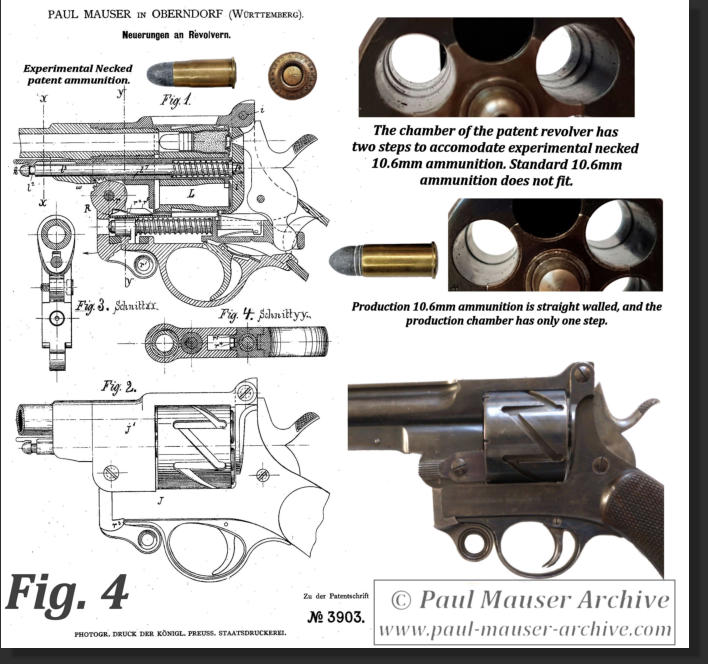
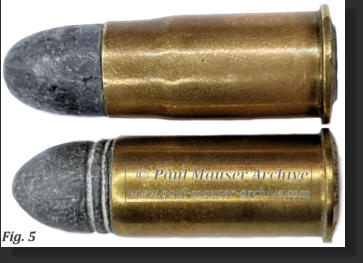
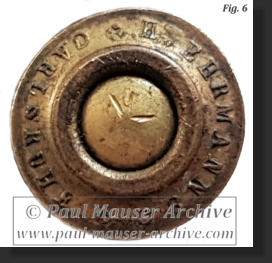





© Mauro Baudino - All rights reserved.



Historical Gallery
Historical Information.
This page summarizes some topics discussed in great details in the Paul Mauser book.The Experimental Paul Mauser C78 revolver.
Mauro Baudino, Co-Author - www.paul-mauser- archive.com Acknowledgement: Marc Erickson for the help in producing this study. The Paul Mauser experimental C78 (Zig-Zag) Revolver in 10.6mm black powder caliber is described here together with associated historical documents from the Paul Mauser Archive and with it's unique experimental ammunition and dismounting tool. This revolver is Paul Mauser's own experimental patent model developed to test and patent the C78 Hinged Frame variation, and documented in German patent 3903 - Innovations in Revolvers on the 9th of April 1878. It is a unique specimen, chambered for an experimental 10.6mm ammunition that is still associated with this revolver; in fact, the drawings in German patent 2564 dated 2nd of March 1878 and German patent 3903 on date 9th April 1878 referred to a specific necked bullet that was not retained in production versions of this handgun (see Figure 4 for the patent). Mauser's patent model can be considered as a laboratory of technical experiments and solutions, some of them retained and others discarded form the final Zig-Zag design. In the Paul Mauser Archive, several letters written from Wilhelm to Paul exchanged in 1878 are available. These letters tell us that Paul personally produced all the early prototypes and patent models of this handgun, and of course the one here presented, while Wilhelm was busy marketing the revolver to the German Army. Wilhelm wrote an average of two letters a day to Paul, one in the morning and one in the afternoon, reporting to him his progress, feedback on the revolver design and the improvements to be implemented. Paul changed these things in the patent model and shipped prototypes to Wilhelm to show not only to the German committee but also to Russian representatives that were very interested). In this short presentation, with the help of some photos, we will discuss the most evident features of the experimental revolver, leaving to a more detailed article the complete analysis of this historic revolver and relevant documentation. A very detailed article with all the historical details from the letters exchanged between Paul and Wilhelm is ready and will be published on the magazine Man at Arms for the Gun and Sword Collector . Figure number 1: The Paul Mauser Experimental Revolver is displayed with the unique necked 10.6mm ammunition that is still associated with the patent revolver; his dismounting tool and two rare documents from the Paul Mauser Archive. The document named Protokoll is the most important management document for both C78 and Reichrevolver made by Mauser and signed by Paul, Wilhelm and the Baron Heh von Luck. The other is one of the letters exchanged with Russian importer C. Wachter & Co. in St. Petersburg. In fact, Russia (Caucasian Army) was particularly interested in the revolver and Wilhelm travel to St. Petersburg to demonstrate it. The Paul Mauser experimental revolver is marked PATENT. on the hinge in order to highlight the primary reason this specific firearm was produced and GEBr MAUSER & Cie OBERNDORF a/N on the left side of the frame similar to the mark found on the solid frame C78 revolver . Figures number 2 and 3: Comparison between the Paul Mauser experimental patent model revolver and early standard production C78 10.6mm number #80. A detailed analysis shows major differences. The most evident are that: • the experimental revolver is in general bigger and the barrel is longer • the safety is not present • the machining of the cylinder grooves is different • the dismounting lever is affixed with a screw • the hammer is attached to the frame with a screw and not with a pin (note that the two screws are quite visible in the patent drawing, see figure 4). • The experimental revolver is chambered for a necked case 10.6mm ammunition and not for the standard straight wall 10.6mm one. • The experimental revolver is marked PATENT. on the hinge in order to highlight the primary reason this specific firearm was produced and GEBr MAUSER & Cie OBERNDORF a/N on the left side of the frame similar to the mark found on the solid frame C78 revolver. Figure 4: The comparison between Paul Mauser's patent model experimental C78 revolver and patent 3903 “Innovations in Revolvers” granted to Paul Mauser on the 9th of April 1878. Figure 5, 6 and 7: The unique necked ammunition was produced by H. Ehrmann & C * CARLSRUHE *. Ehrmann was the forerunner of DWM's Karlsruhe ammunition facility. The factory went from Ehrmann to Lorentz (Deutsches Munitionsfabriken – D.M.), then DWM. It shows the long-time cooperation between Karlsruhe and Mauser, even before the factory in Karlsruhe became Loewe property. The rare ammunition is a concept cartridge that never went into production, in the end Mauser chose to chamber the C78 for the standard 10.6 mm straight wall cased ammunition. Below the necked concept ammunition is compared with the straight walled standard 10.6 mm ammunition. The experimental necked ammunition is 1mm longer than the standard straight one (below in the comparative picture). Both cartridges headspace on the base rim. The chamber of the experimental Paul Mauser revolver has two steps to accommodate the necked ammunition. Of course, the standard ammunition does not fit into the chamber of t he Experimental C78 revolver (see photo below). S t a n d a r d p r o d u c t i o n C 7 8 1 0 . 6 m m a m m u n i t i o n d o e s n o t f i t i n t h e c h a m b e r o f t h e P a u l M a u s e r e x p e r i m e n t a l r e v o l v e r . Figure 8: Together with the revolver, Paul Mauser also designed a dismounting tool. Paul describes this tool to Wilhelm in a letter in 1878. In this letter, Paul also provide a sketch of the tool, to better explain to Wilhelm his idea. The figure below on the left is Paul Mauser's sketch; the patent design drawing is in the middle and a photograph the tool on the right. The tool acquired with the patent model C78 revolver is in new condition. Below is the explanation Paul wrote to Wilhelm concerning the use of the tool: “A tool for the disassembly of the revolver, is also proposed, I suggest to make this device similar to the drawing. Also used for pushing in the small hooked case as is done with the current screwdriver but in a cross shape. A wooden grip is not allowed for the troops, or it could be constr ucted like the screwdriver for the M/71 with the shaft of the screwdriver embedded. Take note of this, please.”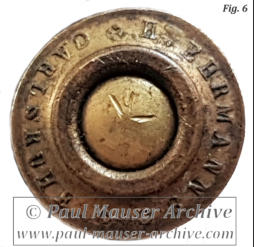
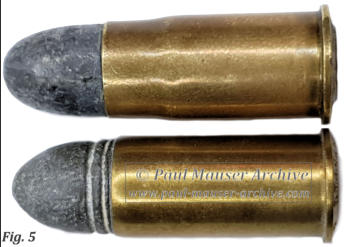
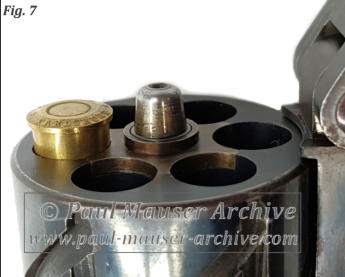
Archive Digitalization
The Archive digitalization is the first step for a serious analysis of the Paul Mauser documents. All the documents are sorted by year and then by type (diary, letters, notes, telegrams...). For each year a folder is defined. Inside it, several folders are associated for each type of document. Each folder contains the scan/picture of the document with the related translation. After this classification, the analysis and interpretation of the documents start. All the undated document are stored in the same folder. For some of them a tentative of dating could be done based on the content. If the content interpretation is accepted then the document is moved in the related year folder.


Paul Mauser ARCHIVE
















